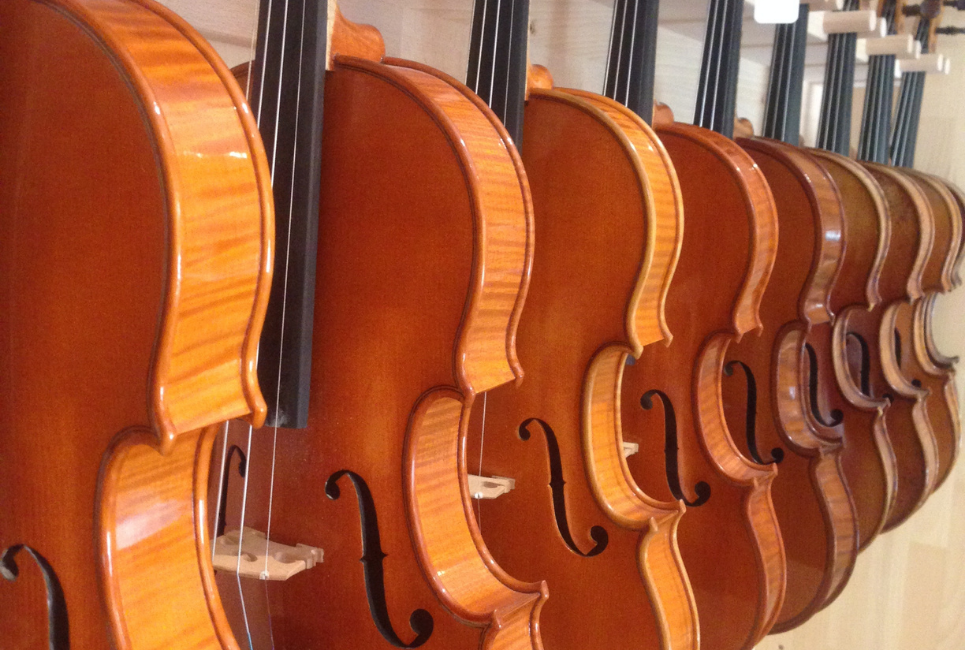- Best Fretted Violins Guide - May 31, 2022
- Best Yamaha Violins Brand Guide - April 13, 2022
- An Honest Mendini MV300 Review - March 31, 2022
Cheap violins are tempting, especially when attached to free 2-day shipping. They look like a great deal. This is Cecilio’s, Mendini’s parent company’s specialty, offering deceivingly cheap instruments and many accessories to entice buyers.
And it works very well, as they are still one of the more well-known producers of low-priced student instruments. While some of their instruments aren’t that bad, others aren’t worthy of being called instruments.
The MV400 falls somewhere in the middle; while it’s not my first choice, I wouldn’t completely throw it off the table either. So let’s get into the nitty-gritty!
Pros Cons & Bottomline
Cecilio/Mendini instruments have a special place in my hierarchy of recommendations, which means they will never be my first choice. I love the MV400 for its overall build, tone, and appearance. But, the violin’s setup and the accessories leave a lot to be desired, as does the overall longevity of the violin and its accessories.
There are higher-quality violins out there; while they cost more upfront, you will spend less over time because you won’t have to fix things like the setup or replace accessories. I recommend checking out Kennedy Violin, Fiddershop, or Shar Music for quality student violins. Or the MV500 or CVN500 if you need a budget student violin.
Pros
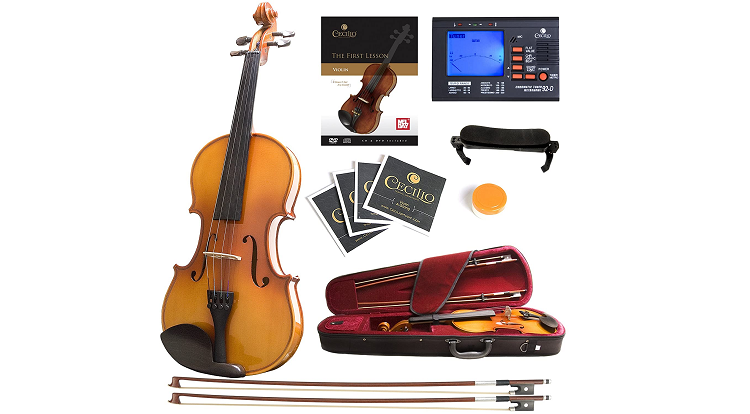
- Inexpensive instrument outfit that can get you started
- A good backup or stunt violin
Cons
- Poor quality setup will result in a trip the luthier, adding to what you need to spend for a playable instrument
- Poor quality accessories that need to be replaced quickly
- Mendini/Cecilio suffer from poor quality control as a brand
- Violin will start to degrade in tone and build quickly and require a complete replacement sooner than higher-quality student violins
Quality Student Violins vs MV400
When I first picked up the violin nearly a decade ago, finding a reasonably priced or budget violin was almost impossible. At the time, Mendini and Cecilio were the biggest brands. Now, this isn’t the case, thankfully, but they still have a solid foothold in the budget instrument market.
The MV400 specifically falls into the middle of the Mendini line. It’s far from the worst that they have to offer, but jumping up the MV500 or CVN500 will give you a slightly better quality violin for not much more money. But what does a high-quality student violin look like, and how does the MV400 compare?
Violin’s Build and Materials
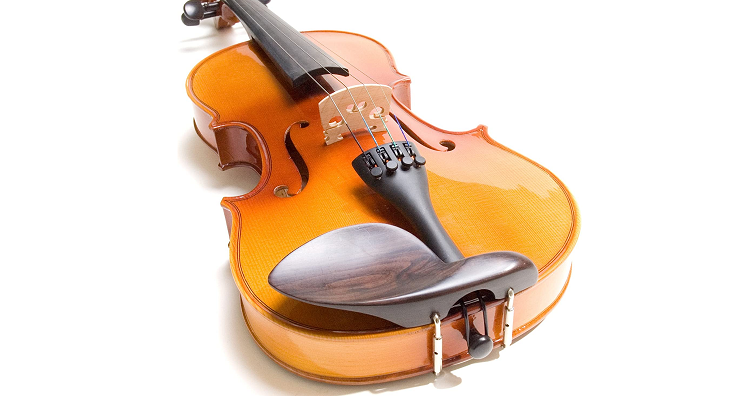
Regardlesss of what playing level it is aimed at, a violin will always be made from spruce and maple tonewoods. Student instruments are made from wood that is sourced anywhere from China to Europe; Europe is the most sought.
Higher quality violins will be made with aged tonewoods; this means the wood has been given time to mature and will produce a higher quality sound faster.
The MV400 follows this formula using unaged tonewoods that have likely been seasoned or dried using a kiln. Overall the tonewoods are of lower quality and potentially have another hidden problem.
Some lower-priced student violins will be made from thinner tonewoods that produce a higher quality sound right away but slowly degrade to sound screechy and essentially fall apart. I won’t say Cecilio is guilty of this, but I wouldn’t be surprised if they were after my experience with my first violin.
By the time I upgraded, the instrument itself was falling apart, and while I had progressed in my skills, I still sounded pretty bad on my new violin. Still, the Cecilio, I sounded considerably worse, especially on higher notes. However, about 4 months ago, the violin itself had sounded passable even on those same high notes.
Fingerboard & Fittings
Ebony is a standard material used for violin fingerboards and fittings. It’s a tough and durable wood, so it is preferred over others. It can withstand the regular wear and tear from the oil on your fingers and the pressure from pressing the strings down. On cheaper violins, you may find maple or even dyed hardwood.
Maple is okay for a lower-priced instrument, and it was last as long as that violin is needed. But dyed hardwood is the mark of a poorly made and potentially unplayable violin. Avoid this description at all costs.
The MV400 features a pure ebony fingerboard; if it’s of good quality or well carved and graduated, I won’t be able to tell you. Many people never notice problems with their fingerboard, but I have seen reports of them being poorly made and fitted to the violin.
Fittings vary from instrument to instrument, ebony is the most common, but boxwood is another wood type that shows up regularly on student violins. It’s really a matter of preference and what looks best with the varnish on the violin. The MV400 features ebony fittings that look classy against the violin’s varnish.
The tailpiece is made from alloy and has 4 built-in fine tuners. Tailpieces can be made from various materials; on most quality student instruments, I see carbon composite tailpieces with built-in fine tuners or ebony tailpieces with removable fine tuners.
Built-in fine tuners on a Cecilio instrument are not my jam at all, and I prefer the models that come with removable fine tuners instead. The built-in ones are more difficult to replace when broken.
The first one on my violin broke pretty quickly, and it was very frustrating as a new player. After tuning by pegs, I’m still excited to have mechanical pegs instead of manual ones because of the ability for minute adjustments.
Quality Setup vs Cecilio
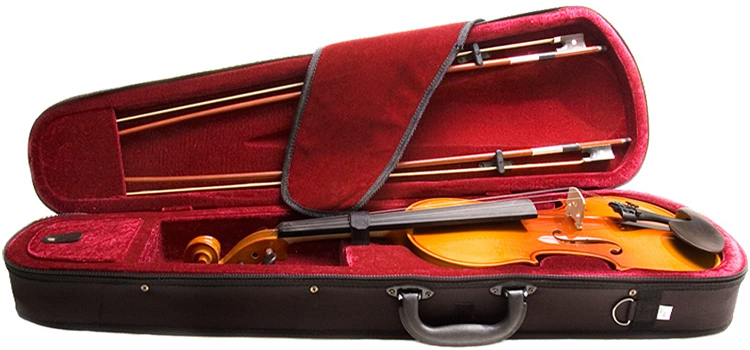
A violin’s setup is the most essential part of any violin. A proper setup means that all of the little details of the violin are perfectly measured and in place. A proper setup has many different aspects ranging from fitting the fingerboard to making sure each peg is correctly fitted to the pegbox.
A few features are by far the most important: the bridge’s shape, string height and distance, and soundpost placement. Along with the strings they use during setup.
Cecilio, in particular, struggles to properly carve and set the bridge with the proper angle and string height. If anything, they fail the most in terms of providing a quality instrument.
While their violins are cheap, they will most likely need a new bridge and other minor adjustments that can run up a repair bill into the 100s, which adds to the overall cost of the instrument.
Additionally, they ship all of their instruments with the bridge down, meaning you or a luthier need to put it in the right spot and place the strings correctly.
This isn’t difficult per se, and after watching a few videos, most adults could do it. However, due to the other problems with the bridge, I recommend taking it into a luthier to be checked and set up anyway.
This can become even more expensive if the pegs aren’t properly fitted, which was the case with my violin. They often slipped and struggled to hold a tune unless I used excessive force to keep them in place overall, just a poor quality setup.
This made the violin uncomfortable to hold, play, and challenging to draw a good sound out of. Upgrading to my Eastman with a proper setup has been a night and day difference.
The strings are one of the last components of a violin’s setup, and they are the easiest to change as well. Mendini instruments come with their in-house branded strings, which are crap.
I recommend upgrading to the standard student string, D’Addario Preludes or Thomastik Dominants. Cecilio branded instruments come with Preludes already, but that is the only difference between the two brands.
A Quality Violin Outfit
Student violins typically come in outfits or kits with extra accessories you need to play or are just nice to have with you. Cecilio is the type of company to give you the whole package and then some.
That doesn’t mean that the accessories are quality and will be useable in the long run, though. They can throw in so many extras because they are impossible cheap to produce and are quick to break.
An outfit typically includes at least a bow, case, and rosin, but many also include a shoulder rest and tuner. These outfits include bows and shoulder rest that could easily cost you an extra hundred. Unfortunately, Cecilio is not one of these companies.
The bow and case are the most important, with the rosin being essential, but I’m not picky about the type of rosin I use. Cecilio includes two bows, but they are typically warped and unbalanced and use poor-quality horsehair.
I got a new bow within the first 6 months, but honestly, if I were ordering a Cecilio violin, I’d add at least a higher quality Brazilwood bow to my cart as well. However, I would recommend buying a Fiddlershop Carbon Fiber bow or equivalent for maximum longevity and use.
The case they include and ship the violin in is a small triangle case that I’m not a fan of, but it gets you through the first couple of years. My only real complaint is how small the storage compartments are. The rest of the outfit includes a shoulder rest, tuner, lesson book, extra strings, and rosin.
The shoulder rest will need to be replaced right away. I didn’t use a shoulder rest for a long time until I got a Fiddlerman one because of how uncomfortable the Cecilio shoulder rest was. Kun and Everest also make great shoulder rests for students and beyond.
MV400’s Tone Quality & Final Opinion
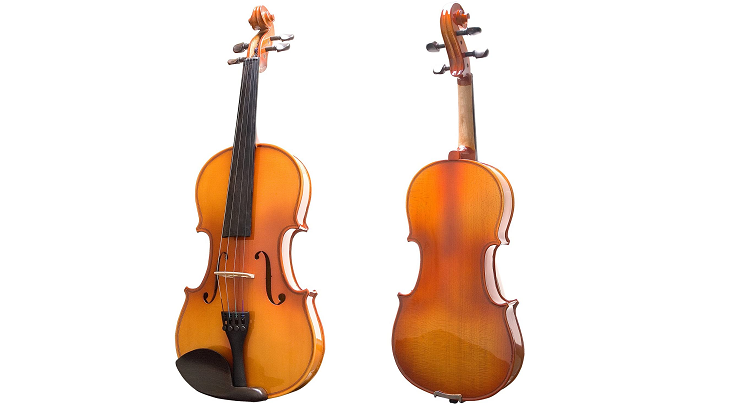
The final question is, what does the MV400 sound like, and is it passable for a student violin? The answer is a resounding yes it’s adequate but unremarkable. It sounds like a lower-end student instrument.
By this, I mean the violin has no personality or oompf, and it’s a little screechy in some areas. However, the overall tone is pleasant enough considering the price, and it would work for the first couple of years. However, don’t expect to take this violin into an orchestra or ensemble setting.
I’ll admit I don’t hate the tone overall, despite its lack of sparkle or pizzaz. It has a subtle sweetness and warmth that feels even across the registers. It helps remove the usual student tinniness.
It definitely sounds like a better-made instrument compared to the lower-end Medini and Cecilio models. Changing out the strings to something like D’Addario Preludes will also improve the overall tone and playability of the violin.
In the end, this violin stays in the budget recommendations bucket because I know there are better violins out there, with higher-quality accessories and perfect setups.
But for someone who wants something inexpensive to mess around on, then Cecilio violins aren’t a horrible purchase, especially for more experienced players who are able to make the adjustments needed at home. However, the bridge may be a hopeless task regardless.
For students, I highly recommend checking out my alternative recommendations! You will receive a higher-quality violin outfit that will serve you better and let you progress faster in your craft.
Alternative Recommendations
While the MV400 will make do for some musicians, these alternatives are perfect for new students who want to own their own violin. You can, of course rent a violin from places like Stringworks and Johnson Strings or your local music store. But if you want to buy one, these are some of my favorites.
I chose these violin outfits primarily based on my own knowledge of the industry, along with the violin’s specifications, value, and overall quality in both build and setup. This means that these violins are made with high-quality materials, set up in the USA, and are tested and inspected by professionals.
These picks are more expensive than any of the Mendini violins. Still, the extra money spent on the violin means you will receive an instrument that is ready to play out of the case, comes with high-quality and usable accessories, and won’t cost you extra money for inspection or setup.
These violins are also playable for longer and potentially even take you into a school or teacher-run orchestra setting.
Top Pick: Fiddlerman OB1 Violin Outfit
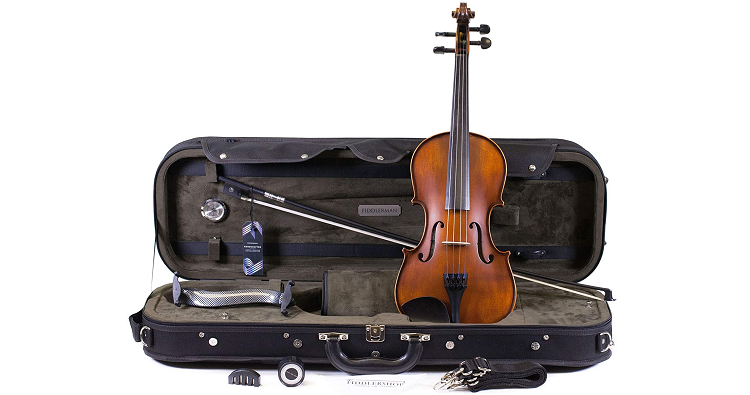
The Fiddlerman OB1 from Fiddlershop is one of my favorite student violins. For the price, you can’t beat the quality and included accessories.
It’s the most expensive option on this list, but it’s also one of the highest quality violins and one that will take you much farther in your musical journey. The OB1 is made from the typical spruce and maple tonewoods that have been dried for 4 years to give the violin a little pizzaz.
It comes fully set up with ebony fittings, a fingerboard, and a carbon tailpiece. The tailpiece has 4 built-in fine tuners that are decent quality, at least in my experience with any Fiddlerhsop violin that has this tailpiece.
The strings are Fiddlerman branded, which up until recently were my go-to strings for their affordability and similarity to Dominants without the tinny break-in period.
The outfit comes with all the high-quality basic accessories, including a Fiddlerman Carbon Fiber bow, which is my current go-to! A shoulder rest, practice mute, rosin, and a tuner are also included in the outfit.
Cheapest Option: Bunnel Pupil Violin Outfit
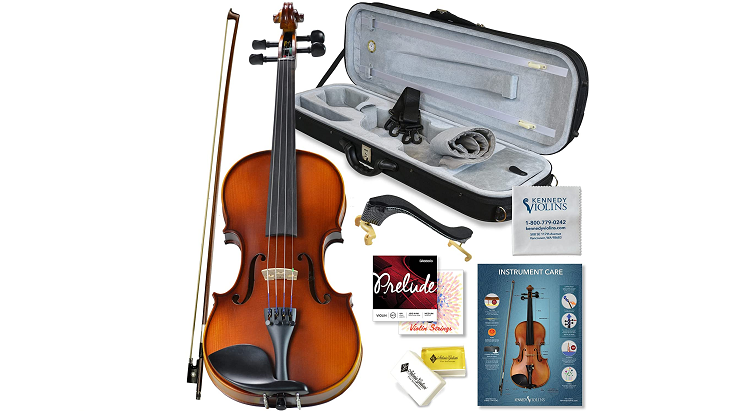
The Bunnel Pupil Violin Outift from Kennedy Violins is the cheapest on this list but a bit more than the MV400. Unlike the MV400, you won’t have to purchase a new bow, shoulder rest, or strings, and you won’t need to get it set up by a luthier. This violin will come with everything you need to get started and ready to play out of the case.
Its made out of solid maple and spruce tonewoods with ebony fittings and fingerboard. The tailpiece is composite with built-in fine tuners very similar if not identical to the Fiddlershop ones. I would not be surprised if they came from the same manufacturer.
The outfit includes a brazilwood bow that will do for a while; when rehair time comes around, I would recommend an upgrade. The case is nice and roomy. In fact, the Kennedy Cases are by far my favorite.
It even has a dedicated shoulder rest spot; it’s so satisfying. The violin comes with D’Addario Prelude strings, rosin, extra portland synthetic strings, and a polishing cloth.
Go To Cecilio Alternative: Tower Strings Rockstar Violin
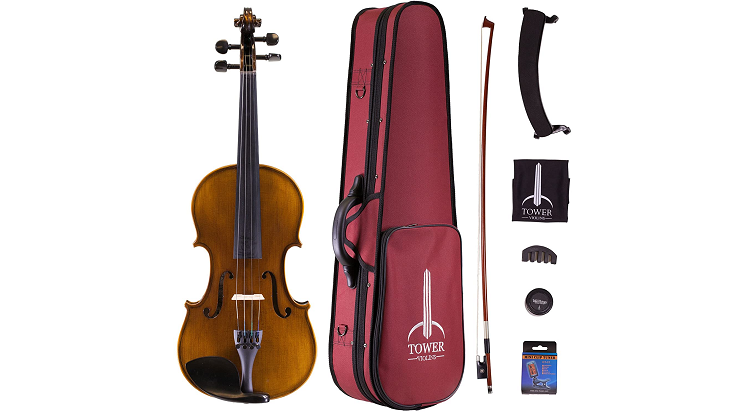
The Tower Strings Rockstar from Fiddlershop is my favorite alternate to Cecilio violins. It’s the same price as the CVN600, but it’s a much better value and a higher quality instrument. Of course, it comes fully set up like all other Fiddlershop violins. The violin is made from spruce and maple tonewoods that have been dried for 36 months.
The fittings and fingerboard are ebony, and the tailpiece is composite with built-in fine tuners. It comes strung with D’Addario Prelude strings.
The outfit comes with a brazilwood bow of decent quality; I still have and use mine for some things. A small triangle case, tower strings rosin, shoulder rest, practice mute, and a digital tuner.
Favorite Kennedy Violin Option: Antonio Guiliani Etude Violin Outfit
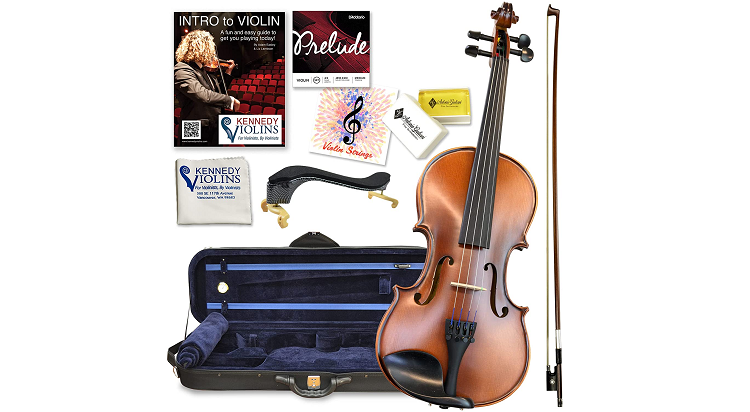
Another pick from Kennedy, Antonio Guilinai Etude, is an excellent pick for a serious student who wants something that will last. This violin follows the typical spruce and maple tonewood formula, with ebony fittings and a carbon tailpiece. Do you sense a theme in what you will find on most student violins?
This violin features an upgraded bridge and wood that has been dried longer compared to the Pupil. But it comes set up with the same Prelude strings, case, bow, and other accessories. Did I mention how nice the case is for a student outfit? It even has a hygrometer to track humidity built-in.
FAQs
Answer: The only real difference between each brand is that the Cecilio violin comes with D’Addario strings pre-installed, and Mendini violins come with their in-house strings, which really are terrible.
Otherwise, varnish colors are different, but that doesn’t necessarily affect the tone or durability of the violin. They all suffer from similar issues regarding material quality and quality control.
Answer: This will really depend on your budget. You don’t need to spend thousands on a violin to get started. I do recommend budgeting for at least 300 to 350.
This will ensure that you purchase a high-quality student violin that you will get your money’s worth regardless of if you sell it later on down the line or keep it forever. Of course, you can spend thousands on a violin as well. It’s up to the player’s discretion.
Answer: I’m a fan of the CVN500/MV500 as they are aesthetically pleasing and sound pretty good for student violins considering their price. But of course, they suffer from the same problems as other Cecilio/Mendini violins.
The CVN600 is also very nice, but the Tower Strings Rockstar is the same price, so I’d recommend that first.
Final Thoughts
The MV400 does the job, but you can find a better violin with ease. Don’t settle for less, instead look for a violin from a quality seller that comes set up in the USA and has high-quality accessories that won’t need to be replaced.
An easy to play and well-sounding violin will be a well-loved musical friend for years, and it’s worth it to invest a little extra into something that will last.
Looking for more interesting readings? Check out:

